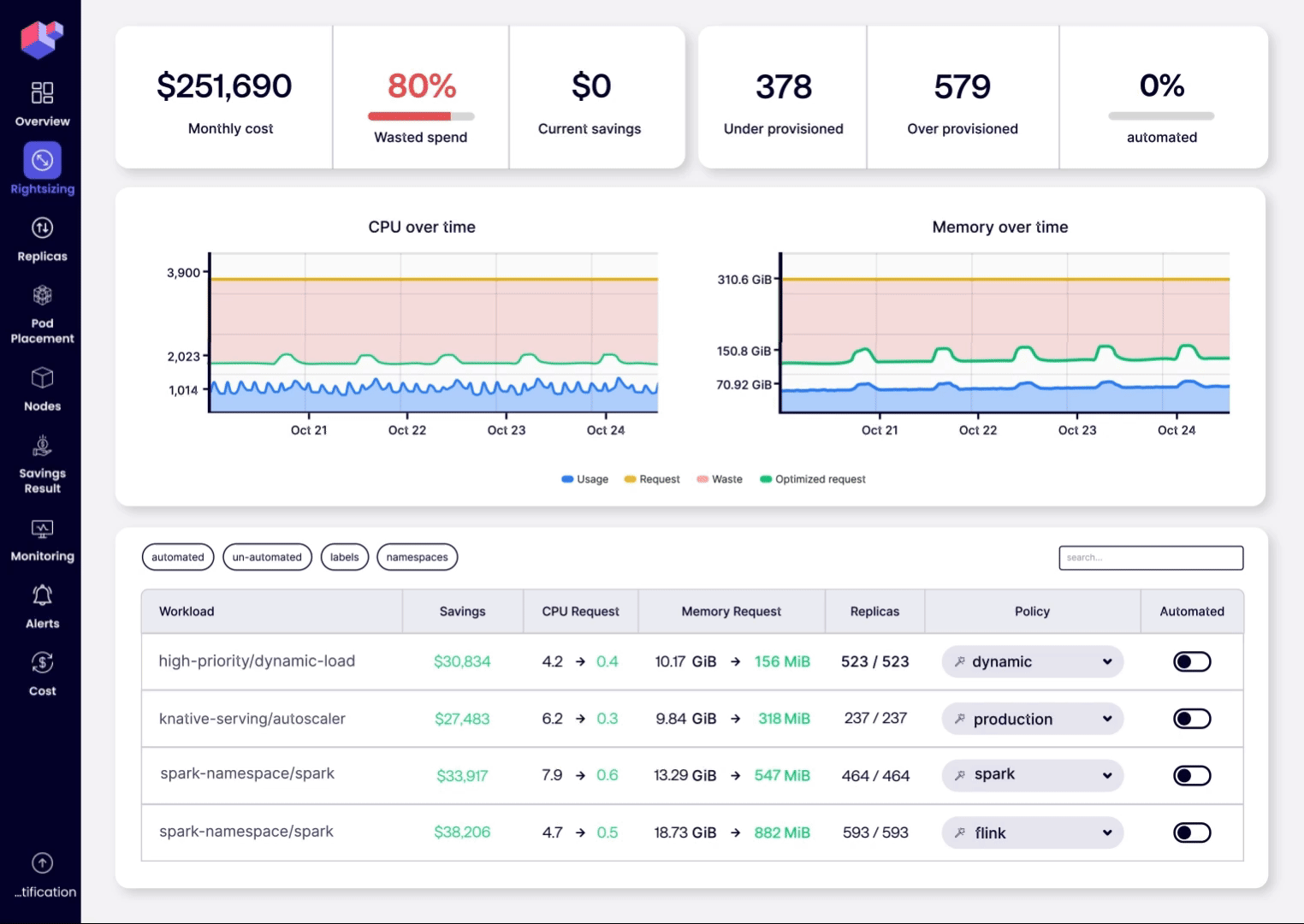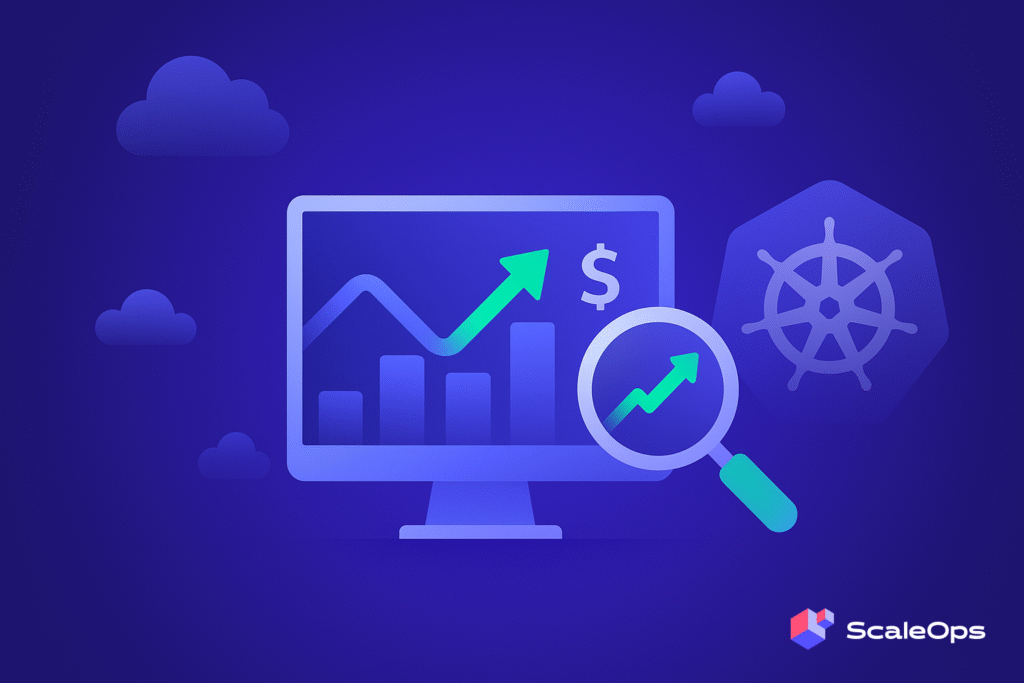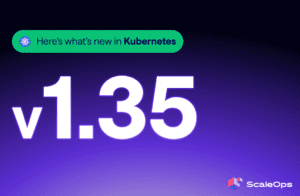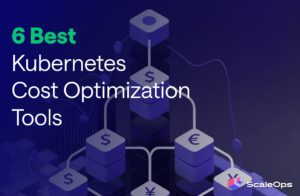As more and more organizations adopt Kubernetes, managing and monitoring cloud costs becomes a critical challenge. And without clear visibility into resource usage and spending patterns, it’s easy to overspend and even easier to overprovision resources.
Cost monitoring is the operational backbone of Kubernetes cost management. Pricing helps you understand the cost model. Optimization helps you reduce waste. But without continuous monitoring, neither is sustainable.
This guide breaks down what Kubernetes cost monitoring really means, why it matters, and how to do it right.
What is Kubernetes Cost Monitoring?
Kubernetes cost monitoring is the practice of tracking, analyzing, and optimizing how much you’re spending running containerized applications in Kubernetes clusters. This process turns raw resource usage (like CPU, memory, storage, and network) into actionable cost insights that help organizations make better decisions about their infrastructure spend.
Unlike traditional monitoring, cost monitoring in Kubernetes needs to account for how resources are shared, scheduled, and constantly shifting. Containers spin up and down. Workloads move. Teams share nodes. Visibility is tough.
Done right, Kubernetes cost monitoring gives you a clear view of where money is going, which teams or projects are driving spend, and where waste is hiding. It’s the foundation for smarter decisions about infrastructure and resource management.
The Challenges of Monitoring Kubernetes Costs
Dynamic Environments
Kubernetes environments are inherently dynamic. Pods and containers are constantly created, scaled, and terminated based on application demand. The dynamic nature of K8s makes traditional cost monitoring approaches, which assume static resource allocation, largely useless.
The ephemeral nature of workloads means baselines shift constantly. Resources scale up and down in seconds. If your monitoring can’t keep up, you’ll miss key cost signals. Gaps in data and inconsistent visibility lead to blind spots. And blind spots lead to wasted spend.
Shared Resources
In Kubernetes, resources are shared by design. And this presents unique challenges for cost management. Multiple teams and applications run on the same nodes, use the same storage, and share network bandwidth. That makes it hard to answer a simple question: who’s spending what?
Shared resources include compute nodes, storage volumes, network bandwidth, and even Kubernetes control plane components. Without clear tagging and allocation strategies, cost visibility breaks down. You can’t tie spend to teams or services. You can’t build chargeback models. And you can’t optimize what you can’t see.
Lack of Native Cost Visibility
Kubernetes itself doesn’t provide native cost monitoring capabilities. While it does give you metrics about resource utilization, CPU usage, memory consumption, and other performance indicators, it lacks built-in functionality to translate these metrics into financial costs.
To close that gap, teams rely on external tools that map usage to cloud billing. That’s challenging enough in a single cloud. In hybrid or multi-cloud environments, with different pricing models and billing formats, the complexity multiplies fast.
Key Metrics for Monitoring Kubernetes Costs
Idle Resources: Identify and quantify unused capacity including over-provisioned pods, orphaned volumes, and underutilized nodes to eliminate waste.
CPU and Memory Usage: Track requested vs. actual utilization across pods, nodes, and namespaces to identify over-provisioned resources and right-sizing opportunities.
Storage Consumption: Monitor persistent volume utilization, storage class costs, unused volumes, and container image sizes that contribute to overall expenses.
Network Traffic: Measure ingress/egress volumes, cross-zone communication patterns, and data transfer costs, especially in multi-zone or multi-region deployments.
Pod and Node Metrics: Analyze resource requests vs. actual usage at the pod level and utilization rates at the node level to optimize allocation and consolidation.
What are Kubernetes Cost Monitoring Tools?
Kubernetes cost monitoring are specialized solutions that provide visibility and insight into the financial aspects of running containerized workloads. These tools bridge the gap between Kubernetes resource metrics and actual cost implications, offering features that native Kubernetes monitoring cannot provide.
Typically, these tools integrate to both your Kubernetes clusters and your cloud billing APIs. They map usage to cost, break down spend by team or service, and help you spot waste. Most offer dashboards, budget alerts, chargeback reports, and even recommendations for optimization.
Some platforms also use machine learning to forecast costs, flag anomalies, and suggest improvements. The best ones work across multi-cloud and hybrid environments, giving you a single view of spend, no matter where your workloads run.
Notable Kubernetes Cost Monitoring Platforms and Tools
1. ScaleOps
The ScaleOps platform combines automated, real-time resource optimization with detailed cost monitoring. Unlike other solutions that provide visibility and report expenses, ScaleOps actively reduces cloud spend by automating resource allocation in real-time, dynamically adjusting CPU, memory, and replicas based on application context-awareness.
ScaleOps provides granular visibility into costs across clusters, namespaces, teams, and applications and seamlessly integrates with AWS, GCP, and Azure billing systems to ensure accurate data that is representative of your invoices.

By automating cloud resource management, ScaleOps not only enhances performance and reliability but also empowers teams to focus on innovation rather than manual configurations. This holistic approach transforms cloud cost management from a reactive task into a proactive, continuous process, aligning operational efficiency with financial accountability.
2. Kubecost
Kubecost is a popular solution for Kubernetes cost monitoring. It provides cost allocation, resource efficiency insights, and detailed breakdowns of expenses across clusters, namespaces, and individual workloads.
Kubecost offers both free and enterprise versions, with the enterprise tier providing advanced features like multi-cluster management, advanced analytics, and integration with business intelligence tools. Kubecost’s strength lies in its comprehensive cost visibility and user-friendly interface that makes complex cost data accessible to both technical and business stakeholders.
3. OpenCost
OpenCost is a vendor-neutral, open-source project that provides standardized cost monitoring for Kubernetes environments. It offers real-time cost allocation, supports multiple cloud providers, and integrates with popular monitoring and observability platforms.
As an open-source solution, OpenCost provides flexibility and customization options while avoiding vendor lock-in. It’s particularly popular among organizations that prefer open-source solutions or need extensive customization capabilities for their specific cost monitoring requirements.
4. CloudZero
CloudZero takes a cloud-native approach to cost monitoring, providing comprehensive visibility across cloud services including Kubernetes workloads. The platform emphasizes cost intelligence and provides actionable insights for optimizing cloud spending.
CloudZero’s strength lies in its ability to provide context around cost data, helping organizations understand not just what they’re spending, but why costs are occurring and how to optimize them. The platform includes advanced analytics, anomaly detection, and integration with popular development and operations tools.
5. Datadog
Datadog offers Kubernetes cost monitoring as part of its comprehensive observability platform. This integration provides the advantage of correlating cost data with performance metrics, logs, and traces, offering a holistic view of application health and financial efficiency.
The platform provides detailed cost breakdowns, trend analysis, and the ability to correlate cost spikes with application performance issues or deployment events. Datadog’s extensive integration ecosystem makes it particularly attractive for organizations already using the platform for other monitoring needs.
How to Build a Kubernetes Cost Monitoring Strategy
- Define Objectives: Clearly identify what you want to achieve with cost monitoring, whether it’s reducing cloud spending, improving utilization, or implementing chargeback models. Set specific, measurable goals aligned with business objectives and timelines.
- Select Appropriate Tools: Choose tools based on your requirements, infrastructure, and budget constraints, evaluating integration capabilities, scalability, and feature sets. Consider multi-cloud support, real-time processing needs, and team training requirements.
- Implement Resource Tagging: Develop a comprehensive tagging strategy for teams, projects, environments, and cost centers to enable accurate cost allocation. Use automation and admission controllers to enforce consistent tagging policies across all resources.
- Establish Monitoring Dashboards: Create dashboards for different audiences, from executive cost summaries to detailed technical views for operations teams. Include key metrics like cost per application, utilization trends, and actionable optimization recommendations.
- Set Alerts and Thresholds: Configure alerting for cost anomalies, budget overruns, and optimization opportunities with graduated alert levels. Design policies that minimize noise while ensuring important events are communicated with sufficient context.
- Regularly Review and Optimize: Schedule periodic cost reviews with stakeholders to analyze trends, evaluate opportunities, and adjust strategies. Use historical data to identify patterns and make decisions about right-sizing, waste elimination, and architectural changes.
- Educate Teams: Provide training on monitoring tools, cost data interpretation, and cost-conscious development practices. Foster a culture of cost awareness through documentation, best practices, and regular communication about monitoring initiatives.
Wrapping up
Kubernetes cost monitoring is essential for teams looking to control spend and get the most out of their container orchestration. It closes the loop between cost visibility and optimization, providing the real-time data needed to take effective action.
Because Kubernetes environments are dynamic and resources are shared, native cost visibility is limited. This makes tracking costs tricky without the right tools and processes.
A solid cost monitoring strategy covers four key areas: choosing the right tools, tagging resources properly, setting up clear dashboards, and building cost awareness across teams. Platforms like ScaleOps show how combining visibility, optimization, and monitoring in one place can reduce complexity and improve results.
Done right, Kubernetes cost monitoring cuts cloud spend, improves resource efficiency, and helps teams align infrastructure decisions with business goals. As Kubernetes adoption grows, this discipline becomes a must-have for staying efficient at scale.























